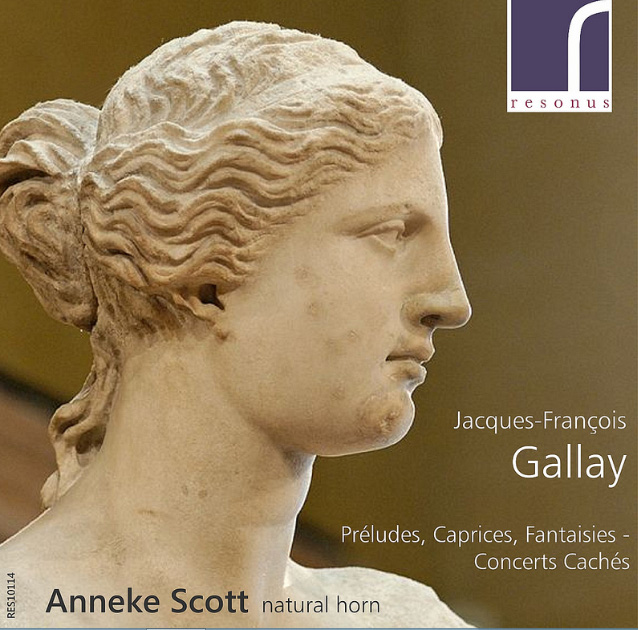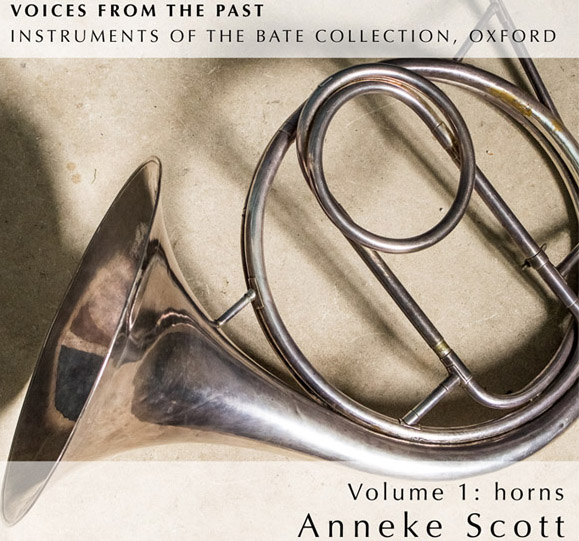
Préludes, Caprices, Fantaisies - Concerts Cachés: Solo Works by Jacques-François Gallay, Resonus, ASCD01, Recorded in the Musée national de Port Royale des Champs, France, on 22-24 November 2010. www.annekescott.com
Two fine recordings by the natural horn player Anneke Scott were recently released. Scott performs in the UK and continental Europe and she is the principal horn of the Orchestre Révolutionnaire et Romantique, The English Baroque Soloists, The Orchestra of the Sixteen, Europa Galante, Dunedin Consort and Players, and The King’s Consort.
This recording is a truly impressive collection of unaccompanied works for horn, composed by the celebrated 19th century French natural hornist Jacques-Francois Gallay. The horn used for this recording is a cor solo by Marcel-Auguste Raoux, built in 1823 and virtually identical to the instrument Gallay played. It was loaned by the Bate Collection at the University of Oxford for the recording, and mScott’s playing on the instrument is breathtaking. Her tone quality is perfectly suited to these pieces, typically vocal in character. The even quality of the open and stopped tones throughout the recording is remarkable. Gallay’s pieces are incredibly challenging, especially when played on a natural horn, and Scott performs these pieces with an ease of technicality that will impress and delight lovers of historic brass instruments.
Scott has taken selections from three works by him, the Douzegrands caprices, Op. 32, the Préludesmesurésetnonmesurés, Op. 27, and the Fantaisiesmélodiques, Op. 58. She has selected individual works from each set and combined them to create groups of pieces as short suites, generally following the formula of Prélude-Caprice-Fantaisie. Each group of pieces is designed to be thematically and tonally connected. The result is stunning because each grouping can be legitimately heard as a short suite, and it is possible to imagine Gallay even performing them in this fashion in one of the many salon performances he gave during his illustrious career.
Another recording consisting entirely of solo works for natural horn does not come to mind, and a quick internet search was unfruitful. The thought of a CD of only solo natural horn pieces may seem monotonous, but such thoughts are quickly forgotten because the performances on the CD are so utterly compelling. Scott has put together an incredible CD that repeatedly delights and surprises the listener.

Recorded 2011-2013 All Saints (New Eltham), Brunel University Studio, Finchcocks Musical Museum, Luxury Noise, and St. Andrew’s Church (West Dean)
Annake Scott and Joseph Walters (horns), Marcus Barcham-Stevens (violin), Robin Michael (cello), Frances Kelly (harp), Steven Devine (pianos), and James Gilchrist (tenor)
Voices from the Past is the first in a series of recordings being released by the Bate Collection of historical instruments at the University of Oxford. This recording features several fine examples of horns from a range of periods and designs, including hunting hornsdating from the early 1700s, up to valved horns dating from the early 20th century (see listing below for further details). Additionally, this recording features other historical instruments, some of which are part of the collection of the Finchcocks Musical Museum in Kent.
Overall, the playing on this recording is superb. The liner notes included with the CD provide concise and enlightening information about each horn, such as basic technical specifications, regional origin,and maker (when known). Surely it must have been an enormous challenge to discover and adapt to the various idiosyncrasies of each instrument. It speaks volumes to Scott’s abilities and talents that she is able to play such a wide range of instruments with equal expertise. The variety of horns heard on this recording is impressive:
|
Anon after Handel, from the Forrest Harmony for two horns (1733-1744) |
cor de chasse by Bennett, London, c. 1700 (Scott) cor de chasse by Hass, Nürnberg, 18th c. (Walters) |
|
Joseph Haydn, Divertimento a tre for violin, horn and cello, Hob IV:5 (1767) |
anonymous hand horn, German, 18th c. |
|
Wolfgang Amadeus Mozart, selections from Duos for two horns, KV. 487 (1786) |
hand horn by Courtoisneveuaîné, Paris, 19th c. (Scott) hand horn by Courtoisneveuaîné, Paris, 19th c. (Walters) |
|
Heinrich Simrock, Thema mit sechs variationen (1805) |
cor solo by Marcel-Auguste Raoux, 1823 |
|
Ignaz Moscheles, Introduction et rondeau ecossais, Op. 63 (1821) |
radius omnitonic horn by Callcott, London, 19th c. |
|
Franz Schubert, Auf dem Strom, D. 943 (1828) |
hand horn with additional 2 Stölzel valve block by Thomas Key, 19th c. |
|
Camille Saint-Saêns, Romance in F, Op. 36 (1874) |
hand horn by Halari, Paris, 18th c. |
|
Richard Strauss, Andante, Opus Posthumous (1888) |
rotary single F valve horn by Sachsische Musikinstrumenten Fabriken, Klingenthal, early 20th c. |
|
Paul Dukas, Villanelle (1906) |
Périnetvalved horn by Couesnon, Paris, early 20th c. anonymous French early 20th century straight mute |
As stated, the overall quality of playing on this recording is superb. The production quality is also quite good, though some selections leave me wishing for a better acoustic. On a positive note, many of the selections have the added touch of feeling like live performances, even intimate chamber music performances, because the recordings include the sound of the musicians breathing. Furthermore, in Dukas’s Villanelle, the sound of the valve mechanisms clicking on the horn can clearly be heard during technical passages. These “ambient” sounds add to the overall feeling that the listener is in the company of the performers and lend an authenticity that seems fitting for a collection of recordings on period instruments.
I was a bit disappointed with the sound quality of a few selections on this recording. For example, the recordings of Dampierre’s hunting horn fanfares were apparently done in a church, but the overall sound gives the impression of synthetic reverb, especially in the “echo” passages. This issue with the reverb can be heard on some of the other selections also, namely the Handel, Haydn, and Mozart pieces. However, the sound quality is much more authentic and acoustically pleasing on the other selections on this CD. This fact, when combined with the overall high quality of playing, definitely outweighs my concerns over the somewhat artificial sound of the reverb on the few tracks mentioned above.
Scott’s command of the horn is truly impressive. Her playing demonstrates a wide range of emotion, expression, and varied tone quality. Technical passages flow with ease and grace and louder dynamics possess an appropriate amount of brassiness in the sound. The standout performances on the recording include Simrock’s Themamitsechsvariationen, Schubert’s Auf dem Strom, Strauss’s Andante, and Dukas’s Villanelle. In the Simrock, the balance between the horn and harp is impeccable and Scott’s playing is wonderfully delicate and sensitive. The single action harp (c. 1800) played by Frances Kelly sounds fantastic. This recording was the first time I heard Auf dem Strom performed on a two valved horn, combining the use of valves with hand-stopping. It was very interesting to hear the piece as it most likely was played by Joseph Lewy at its premiere in 1828. The tenor, James Gilchrist, is a musician of the highest caliber. His voice and singing style can be easily compared to the sound and artistry of other fine English tenors, such as Pears, Langridge, or Bostridge. On the Strauss, Scott’s long phrases and lush tone quality are perfectly suited to the Romantic composer’s masterpiece. And Scott’s performance of the Villanelle sparkles, especially in the passages that require hand stopping and echo effects.
-- Eric Brummitt


